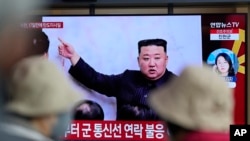North Korea said it had tested a new intercontinental ballistic missile that uses solid fuel – a claim that, if confirmed, would give Pyongyang the ability to conduct quicker and more unpredictable launches that target the United States.
The official Korean Central News Agency said North Korean leader Kim Jong Un oversaw the Thursday launch of the Hwasong-18 missile, which it said would dramatically improve the country's strategic deterrence and nuclear counterattack posture.
Kim “expressed great satisfaction over the miraculous success” of the test, KCNA reported, adding that the country’s enemies will now “face extreme uneasiness and fear … thus making them regret for their wrong choice in despair.”
North Korea has long wanted to develop solid-fueled ICBMs, which in theory are much harder for adversaries like the United States to detect and try to intercept.
Before now, all three of the ICBMs North Korea has tested used liquid fuel, which must be loaded into the rocket in a process that can take hours and require sophisticated equipment that is easily visible from space.
Solid-fuel rockets, however, are pre-fueled. Solid fuel is also more stable, making such missiles easier to move in potential wartime scenarios.
Kim, daughter watch launch
State media photos showed Kim holding hands with his young daughter as they watched the missile emerge from a slender billow of bright, orange-tinted smoke.
KCNA provided relatively few technical details about the new missile, including its maximum range.
In a statement, South Korea's military characterized the test as preliminary, adding that "additional time and effort" were needed to master the new long-range, solid-fueled missile system.
South Korea possesses "more efficient and advanced solid-fuel propellant ballistic technology," the statement added.
Kim Dong-yub, a professor at Seoul’s University of North Korean Studies, agreed that the test appeared to be developmental and that he expected several more launches in the future.
“The developmental process is quite fast,” Kim said. “We should not overestimate the Hwasong-18, but we should avoid underestimating it, too. Yesterday's launch was definitely a success.”
South Korean officials say the missile flew for 1,000 kilometers before landing in the sea between Korea and Japan.
The launch caused momentary confusion in Japan’s northernmost main island of Hokkaido, where residents were warned to take shelter in their basements and train service was briefly paused.
The White House strongly condemned the test, which it said “needlessly raises tensions and risks destabilizing the security situation in the region.”
“The door has not closed on diplomacy, but Pyongyang must immediately cease its destabilizing actions and instead choose diplomatic engagement,” the U.S. statement said.
Numerous tests
North Korea has conducted three ICBM launches this year alone, along with many other tests of smaller missiles. It has insisted that some of the launches are a response to expanded U.S.-South Korea military drills held last month.
However, North Korea has many other potential reasons for launching missiles, including developing new systems, demonstrating deterrence and signaling resolve to its own people.
The United States and its allies expect North Korea to continue conducting major weapons tests in the coming weeks.
North Korea has vowed to launch a military spy satellite in April and has carried out multiple tests it says are designed to accomplish that goal.
Pyongyang has also recently hinted it could conduct a long-range missile launch at a normal rather than lofted trajectory. In the past, North Korea has used a steep angle in such launches, in part to avoid sending weapons over the territory of its neighbors.
North Korea sometimes conducts major weapons tests around key holidays. On Saturday, North Korea will celebrate the “Day of the Sun,” which celebrates the 111th birthday of the country’s late founding leader, Kim Il Sung.










